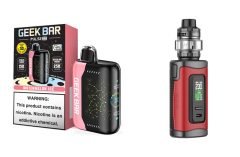Table of Contents
Spinfuel Guide To Vaping – MilliAmp Hours
Introduction
As a new Vaper, one of the technical specifications you’re bound to run into when dealing with the question of which hardware to buy comes along when you’re choosing your battery. Whether you’re selecting from the options of Halo G6 batteries for your first starter kit, choosing between an eGo Mini, eGo Twist, or eGo pass-through, or choosing the standalone 18350, 18490, 18500 or 18650 batteries to power an Advanced Personal Vaporizer (APV) or mechanical mod, you’re going to see a specification attached to any of those choices. Specifications like 320mAh, 650mAh, 1100mAh, et cetera.
But what do those numbers mean? More to the point, what do they mean when it comes to your choice in battery options? Read on and I’ll tell you.
Technical Definition
Let’s begin with the technical definition of the term, “mAh.” It’s a contraction for “milliAmp hours,” or, to decompress it entirely, “milliAmpere hours.”
An Ampere hour (Ah) is the amount of electrical current a battery can deliver to a device in one hour. A milliAmpere hour, simply stated, is one one-thousandth of an Ampere hour. Most PV batteries’ capacities are listed in milliAmpere hours, or mAh, despite the fact that some, such as 2000 mAh 18650 batteries, could be listed as 2Ah batteries. It’s my belief that batteries of this type are simply rated in mAh for the sake of consistency in numbering.
With that out of the way, let’s move on to what mAh mean to you, the PV user.
What It Means To You
Below, I’m going to present a brief chart. I want you to understand that the numbers I present should not be taken as gospel; they’re based on my own personal experience and ballpark guidelines. Because your style of vaping will vary from my own, my usage times will not necessarily be identical to the usage times you’ll experience — but they should be very close.
Additionally, not every battery performs the same as every other battery with the same mAh rating. Different manufacturers use different techniques to extend the usable life of their batteries between charges; some, like Halo does with their G6 batteries, even have it as a point of pride that their batteries last longer than the competition’s, despite their batteries having a similar mAh rating.
The following list will present an example battery, the mAh rating, and the approximate endurance between charges, in either hours or days:
Blu standard battery – 85-90mAh – 45 minutes
Halo G6 78mm automatic KR-808-D1 battery – 320mAh – 2-3 hours
eGo standard battery – 650mAh – 6-8 hours
18350 standalone battery for APVs and mechanicals – 800mAh – 10-12 hours
eGo pass-through battery – 1000mAh – 10-12 hours, indefinitely while in pass-through operation
18650 standalone battery for APVs and mechanicals – 2000mAh – 16-18 hours
I’d like to point out that the preceding timeframes are for solid use and don’t include idle time while sitting unused. I’ve had a single 18650 powering an iTaste VTR remain at over half charged for several days, and have stretched an 800mAh iTaste VV 3 to two days before it needed recharging.
Again, the preceding is merely a very ballpark guideline to what you can expect from batteries of various mAh ratings.
However, you also need to be aware of a couple of factors that can modify those timeframes. Let’s go into a couple of them now.
What can alter battery performance between charges?
One of the most serious factors that can modify how long your battery will perform between charges is whether you’re using a standard resistance or low resistance atomizer on the battery.
I’ll go into resistance more fully in an upcoming article. For now, let me give you the ballpark figures, and then tell you my experience of how low resistance works, and of why — and how — it affects battery endurance.
Standard resistance, in my experience, ranges from 2.2 to 2.6 ohms.
Low resistance, in my experience, ranges from 1.5 to 2.0 ohms in pre-assembled atomizers. Hand-wrapped coils such as those found in rebuildable atomizers can range quite a lot more widely, from 3-plus ohms all the way down into the sub-ohm range. Sub-ohm and ultra-high resistance are outside the scope of this particular article, though, so we’ll stick to the generally accepted ranges for pre-assembled devices.
To keep things very simple with regard to resistance, imagine that the atomizer is a slide on a playground, and electricity is people, sliding down the slide. Standard resistance is the slide as you would normally find it on a nice, sunny day. A few people can slide down it in any given time, because there’s just enough resistance to slow the flow of people moving down the slide.
Now imagine that low resistance is what happens when somebody pours vegetable oil down the slide. People can move down the slide with less friction, which means that the flow of people down the slide is a lot more intense.
Similarly, in a standard resistance atomizer, the electrical current from the battery flows at a steady rate; comparatively, in a low resistance atomizer, current is able to flow more freely into the coil, which means that it’s depleted from the battery at a faster rate.
How markedly this will affect your battery’s time between recharges is dependent on your battery’s mAh rating and on the resistance of each individual AD you use on the battery. That’s something you’ll have to discover, then with each individual combination of battery and atomizer.
I hope that this has given you a basic understanding of mAh ratings, and that it will help you in selecting your battery of choice. Until next time, happy vaping!
John Castle




